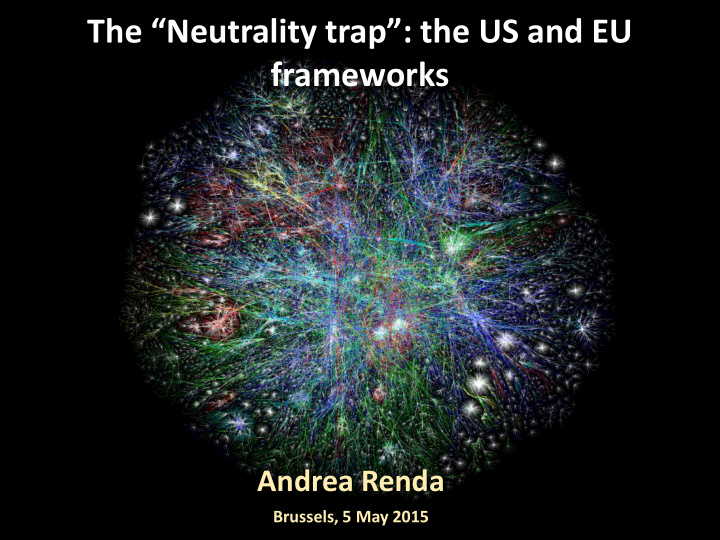



The “Neutrality trap”: the US and EU frameworks Andrea Renda Brussels, 5 May 2015
I NTRODUCTION : BEWITCHED BY NEUTRALITY ? Policymakers are mesmerized by the word “neutrality” Originally, only at the infrastructure layer Increasingly, at the application, “platform” and cloud layers Several examples of “neutrality - oriented cases”: FCC new Open Internet Order EC antitrust case against Google EP vote on Connected Continent New call for “platform regulation” in the EU DSM dossier
T HE N ET NEUTRALITY SPECTRUM Over the past decade, several countries have taken action on net neutrality All of them imposed transparency, but there is wide divergence on “reasonable” traffic management ??? NL UK EC/BEREC Europarl Mandatory NN Net diversity US Canada (just transparency) 3 Is this divergence plausible given the global nature of Cyberspace?
T RANSATLANTIC DRIFT ? The new FCC Open Internet Order is likely to create significant uncertainty in the US market: the resulting level of required neutrality is still obscure Reasonable traffic management is permitted No bright-line rule on mobile – a case by case appraisal of technological specificities The rules have to be appraised in light of the different regulatory framework that applies in the two regions Different treatment of access to broadband networks Different approach towards neutrality at the higher layers
W HY DID WE WANT NEUTRALITY IN THE FIRST PLACE ? Anonymity Competition and fair business practices Innovation User choice Openness Freedom of expression/Pluralism
I S NET NEUTRALITY THEN A GOOD CHOICE ? It is the best policy option if its prospective net benefits are greater than those of any other alternative Dynamic efficiency Type I and II errors Litigation costs Transaction costs Impact on fundamental rights …
F IVE MYTHS ... 1. The net is neutral 2. Users always want a neutral Internet 3. Neutrality always helps start-ups 4. With diversity, QoS fees would be positive and supra-competitive 5. With diversity, market power would necessarily accumulate in the hands of ISPs
D ILEMMAS AND CONTRADICTIONS ON THE EU SIDE Imposing too strict neutrality rules can hamper traffic optimization (in particular, in 5G) At the same time, how could one implement a more flexible rule allowing for specialized services? Can ISPs be neutral and at the same time be made responsible for their subscribers’ behavior? Online intermediaries (including search engines) cannot be neutral: if they were, they would be useless Online intermediaries cannot be obliged to act neutrally and also to filter traffic, protect privacy and children, combat hate speech and foster pluralism! 8
CONCLUSIONS (1) • Net neutrality at the infrastructure layer might have some merit, but would not make the Internet neutral • Net neutrality legislation might even turn out being the best choice, but for reasons that differ from the ones typically invoked • Users benefit from a non-neutral Internet • Search & platform neutrality are fundamentally flawed principles that contradict Internet economics • Neutrality is a very poor and ineffective recipe for media pluralism 9
CONCLUSIONS (2) • Managing incentives is very important: neutrality obligations would not necessarily have the same impact in the US and the EU • Technology is plastic: depending on the rules, investment might move towards private networks, and traffic management can be done at lower or higher layers • Regulating technology with technology: the next frontier of the debate? 10
Thank you! fff
Recommend
More recommend